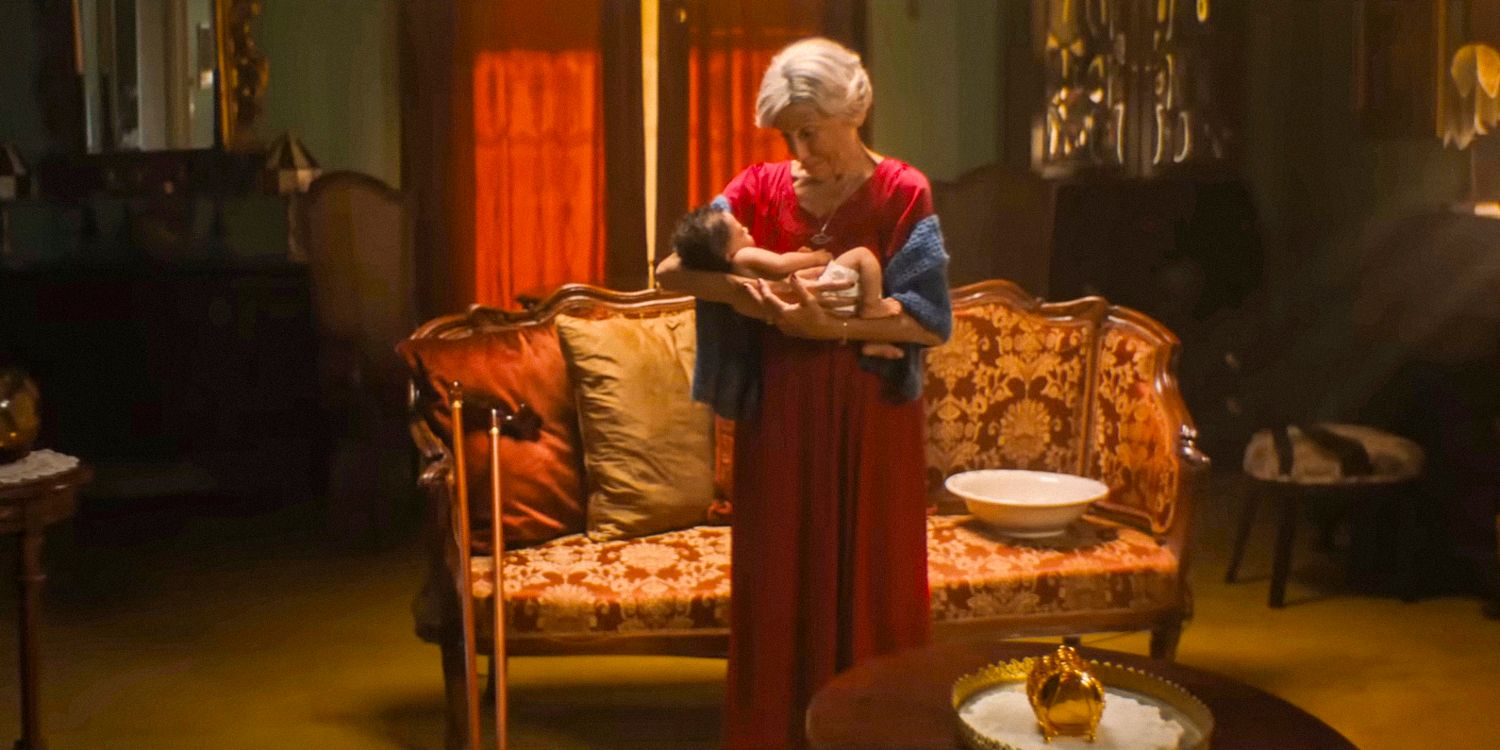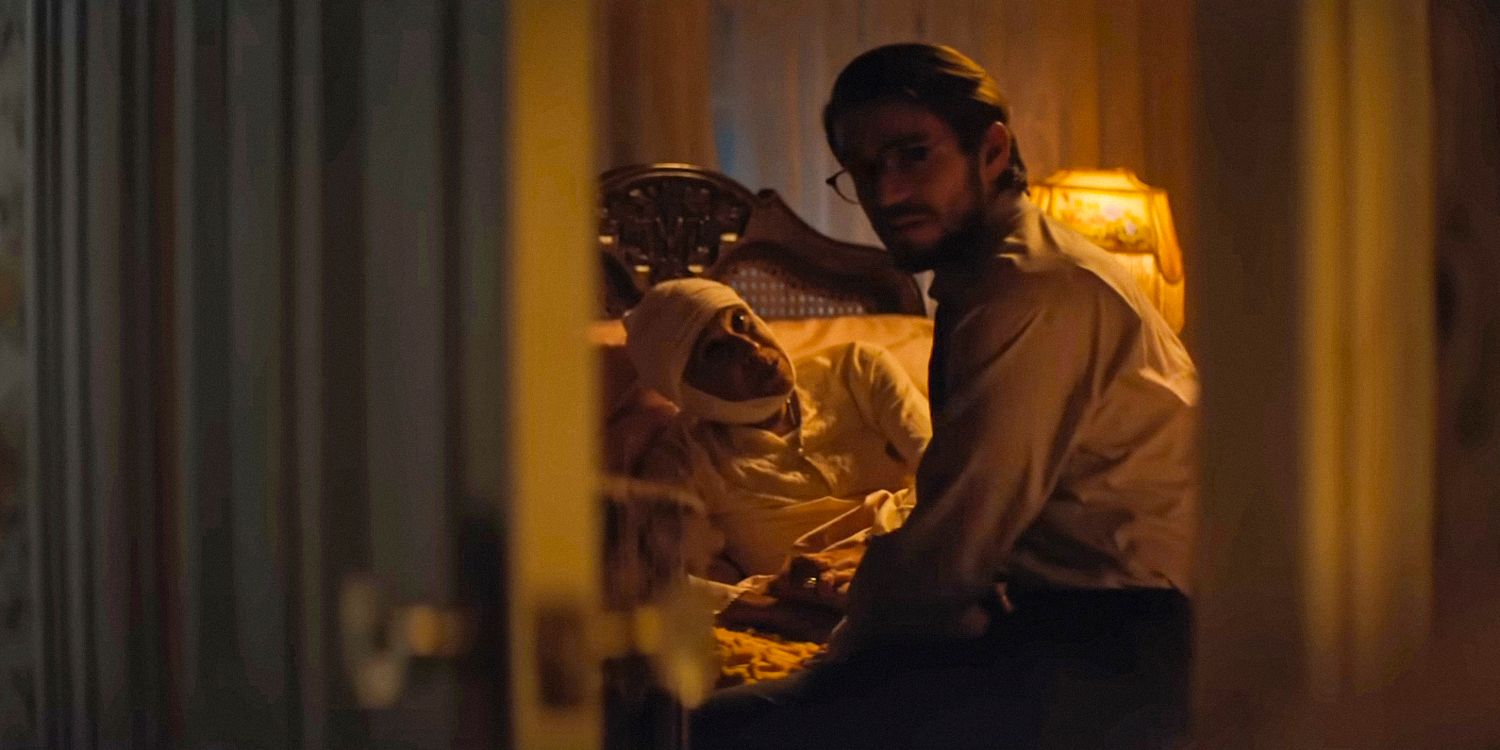The following contains spoilers for The Front Room
The ending of A24’s The Front Room is a dark but powerful victory for Brandy’s Belinda. The directorial debut of the Eggers Brothers and based on a short story by the acclaimed author Susan Hill, The Front Room is a character drama focused on a pregnant woman and her husband having to take in a hateful old woman. The tense A24 movie’s central drama is between Belinda and her husband’s step-mother Solange. After she moves in with them, their relationship becomes more toxic and confrontational.
Forced to accept Solange’s presence in their house to earn a windfall inheritance, Belinda and her husband Norman do their best to make peace with the elderly woman. However, Solange’s attempts — both subtle and overt — to take over Belinda’s role as the maternal figure in her own life pushes the latter until Solange dies late in the third act. Even that act comes with a grim but strangely victorious moral that plays off the film’s themes, with Brandy and Kathryn Hunter’s performances highlighting the story’s grim moral.
Why Belinda Kills Solange & What Happens To Her Next
Belinda Gets Everything She Wanted Thanks To Murder
The ending of The Front Room reveals Belinda secretly smothered Solange with her pillow, giving the protagonist of the film a dark and vindictive victory over her monstrous mother-in-law. As Solange’s efforts to sabotage Belinda’s relationship with Norman and their daughter seem to be taking effect, Belinda convinces her husband that his stepmother is fooling him by proving she bit their baby daughter. Although the film cuts to the next morning and implies Solange passed away in the night, the ending reveals the truth. It seems that actually harming Belinda’s child crossed the final line for Solange.
Solange’s death is a harsh moment, but one the film treats as a vindictive victory. After her death, Belinda’s life improves immensely. She finds a new job, gets a new home, and even prepares to have a new child with Norman. Belinda sings in the film’s finale, having decisively won against Solange. While this is a harrowing act, it’s also one that feels justified within the story as a brutal but necessary choice. The final shot of a calm and confident Belinda underscores her lack of regret in her decision, framing the film’s solitary murder as a justifiable act.
Is Solange Supernatural In The Front Room?
The Film’s Dark Solange Subtext Is A Fake-Out
Part of the tension in The Front Room comes from Solange’s deeply held and aggressive Christian beliefs contrasting with Belinda. A professor with a focus on world religions, Belinda and Norman’s home includes many small statues and pictures connected to her personal faith. Solange’s arrival sets up a series of extreme Christian imagery, which only becomes more pronounced and unusual when members of Solange’s congregation arrive to visit Belinda’s child. Throughout the film, there’s an unsettling element to the tension, a question of whether Belinda is imagining some of the effects or if something almost supernatural is going on.
Ultimately, despite some effectively deceptive edits and visually charged shots, it doesn’t appear as if Solange is actually supernatural in T he Front Room. These moments seem to be more rooted in Belinda’s perspective on living with Solange, visualizing her fears by painting Solange as a perfectly nurturing Virgin Mary when she finds herself having difficulty breastfeeding. These moments seem to be rooted in Belinda’s head, but Solange reinforces the imagery by repeatedly trying to enforce her beliefs and dogma onto Belinda and her family. It’s almost overwhelming, giving it the air of something unnatural.
Why Solange Fails To Turn Norman Against Belinda
Solange Tries To Repeat A Cycle Of Abuse With Her Step-Son
Solange’s efforts to turn Norman against Belinda are central to the plot in the latter half of the film. Solange is Norman’s step-mother, and the film immediately sets up his dread over having to interact with her again. Early in The Front Room, Norman warns Belinda about her treatment of him as a child. Her efforts to replace him as her mother and to instill her beliefs into him were borderline abusive. The grown man remains furious with her, but there’s an undercurrent of lingering fear baked into the character. This treatment steadily browbeats Norman.
|
Main Characters In A24’s The Front Room |
Cast |
|
Belinda |
Brandy |
|
Solange |
Kathryn Hunter |
|
Norman |
Andrew Burnap |
He steadily stops standing up to her and even grows increasingly protective of Solange. This aspect of Norman is one of the film’s tragedies, a cycle of abuse and trauma that Norman initially escaped but has to accept anew for the sake of his own family. Norman only realizes the full scope of Solange’s actions in the third act, when Belinda proves Solange bit their baby by pointing to the missing tooth and how it matches the bite mark. This is when Norman finally turns his back on Solange, although the film implies that he was unaware of Belinda’s actions.
How The Front Room’s Daughter Of The Confederacy Connects To The Movie’s Themes
The Front Room Gives Solange & Belinda’s Fight A Racial Subtext
The Front Room highlights the tension between Belinda and Solange by revealing early in the film that Solange is a Daughter of the Confederacy. The organization of neo-Confederate supporters is highly controversial, given their memorialization of the Confederate army that wanted to continue enslaving people. Belinda is justifiably angry with the discovery that Solange still holds a certificate of her connection to the group, and Solange tries to brush off accusations of racism even while citing offensive stereotypes and assumptions about Belinda based on her race.
This tension is one of the most palpable elements of The Front Room, especially once Solange begins to treat Belinda not just as a daughter-in-law but as a servant to aid with her failing body. It’s a purposefully uncomfortable element of the film that works because of stars like Brandy and Kathryn Hunter’s fully committed performances. It gives Solange’s efforts to take over Belinda’s house an even harsher element, recalling centuries of mistreatment of people by wealthy Caucasians, and gives Belinda’s decision to kill her extra weight and motivation.
The Real Meaning Of The Front Room’s Ending
The Front Room Is About A Harsh Decision Being Necessary For The Future
The Front Room is thematically about a new generation confronting the older one, and forced into a situation where they can repeat the abuses of the past or break the cycle by any means necessary. Belinda is confronted on all sides by Solange’s encroaching influence, which looks to overwrite Belinda’s culture, family, and life. Belinda being pushed to the edge and killing Solange is the logical end of the story as presented, turning the building resentment and righteous fury into something deadly. What makes the ending interesting is the fallout.
There’s no suggestion of guilt in Belinda at the end of The Front Room. There’s no haunting curse or looming evidence that could upend her life. Surviving Solange and ultimately killing her earns Belinda her happy ending. It allows her culture to regrow and her family to expand. Belinda wins in the ending of The Front Room, and only does so by finally having enough of Solange’s actions and ending her threat and presence once and for all. The Front Room has a brutal ending, but a darkly rewarding one given the film’s themes about culture and overcoming the past.


